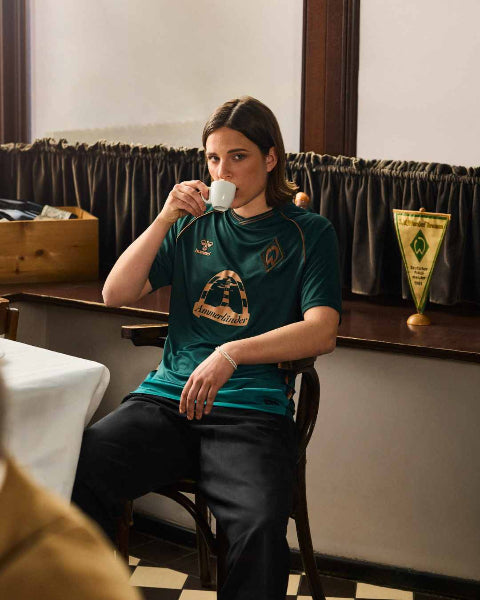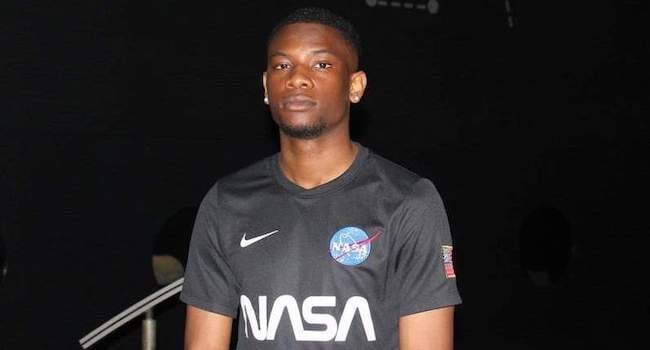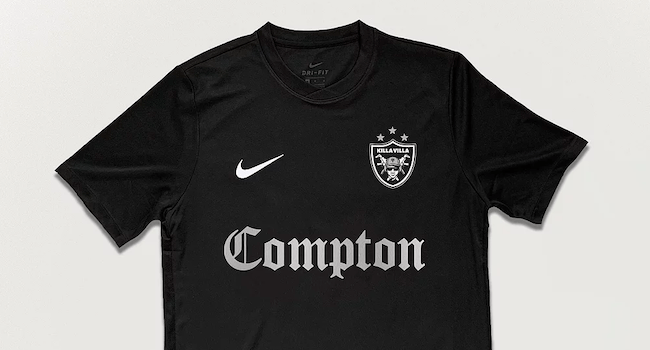Recently added
Vintage shirts
Concept kits
Legends
Football rebrands: What, why and who?
by Mike Maxwell February 05, 2022 8 min read 7 Comments

In amongst the complaints about VAR and the praising of Kylian Mbappe and Erling Haaland, you might have noticed more talk about ‘rebrands’ on your social feeds recently. Whether it is the rumours coming from Inter Milan, or the latest acquisition made by the Red Bull Group, rebrands are becoming commonplace at football clubs.
We have looked into some recent and historical examples of these club rebrands, to find out exactly what a rebrand is, why clubs are rebranding, and who is doing the rebranding.
The 'What' of football rebrands
re • brand
Verb
To change the corporate image of a company or organization.
Exp.: “If there’s one team that didn’t need a rebrand, it’s Inter Milan.”
What is a club rebrand? Well, going by the definition above, it’s when a club changes some aspect of its identity or image. While that might sound simple enough, it is how clubs - or sometimes a sole, stubborn owner - approach these changes that can be the success or failure of these rebrands.
In doing this, difficulty can come firstly from the fact that the image of a club, or its ‘brand’, is something which fans usually hold dearest to them. In the modern game managers and players will come and go, but the club itself - its look, its identity, its image - is usually the one constant for supporters. In many cases it is something that may have never changed in a fan’s entire time supporting their club, and nobody likes change.
Secondly, there is so much that can change with a club rebrand. A club’s image encapsulates so many things, from its colours and crest, to its location and name.
Sometimes rebrands opt for just a change in club crest, as Juventus did in 2017. On the more extreme end of the spectrum we have the type of approach that saw Wimbledon become MK Dons, when new owner Pete Winkelman changed the club’s name, stadium, colours and crest, effectively wiping out the history of a club that had previously existed for over 100 years.
Peter Winkelman (MK Dons)
— Jonny Sharples (@JonnyGabriel) May 6, 2018
Winkelman didn't invest in MK Dons, he invested in Wimbledon and then moved the club 60 miles away to Milton Keynes. Next season, the reformed AFC Wimbledon will play in a division above MK Dons for the first time. pic.twitter.com/kdmybS1NOW
Despite these two rebrands differing in severity, both were met with hefty disdain from fans of the clubs involved, and in large part from the wider football world too. This reaction tends to be the norm when a club embarks on a rebrand, and so it raises the question: why do the clubs still embark on this process if they can almost guarantee a supporter backlash?
The 'Why' of football rebrands
While Winkelman’s intention was financially motivated - the move to a new stadium would see higher gate-receipts and locate the club near to a retail development that Winkelman was also invested in - modern club rebrands are typically focused more on reaching new demographics.
In some cases this may be a younger generation, with clubs vying to capture their own slice of the trend driven ‘gen-z’. New and more engaging designs can help to do this, especially when rolled out with the right viral social media campaign.
Alternatively, they might be looking to gain supporters in a new country, and alter their image to appeal to the fans of one country based on market research. Cardiff City fans will remember this sort of approach from the early years under Vincent Tan.
Vincent Tan (Cardiff City)
— Jonny Sharples (@JonnyGabriel) May 6, 2018
Bought a club nicknamed the Bluebirds and changed their blue kit, blue crest and blue seats in the Bluebirds' stadium to red. pic.twitter.com/CzWuioSwLw
Of course, in attempting to reach these new demographics clubs hope it will lead to financial benefits in the form of clicks, shirt sales and subscriptions, but clubs are unlikely to lead with that aim in quite as brazen a way as Pete Winkelman did.
Another reason for a rebrand may be to simply update the club for the modern age. This was no more apparent than in the NFL last year, when the team formerly known as the Washington Redskins changed their name temporarily to the Washington Football Team, admitting that the term ‘Redskins’ had no place in the name of a modern football team. The team will continue with the WFT moniker for the start of next season, before unveiling a new identity the year after.
The Washington Football Team has announced they will play one more year without a name before choosing a new identity for the 2022 #NFL season.
— Chris Creamer (@sportslogosnet) February 23, 2021
The whole story from our own @AndrewMLind right here: https://t.co/C1Z7smfRZm pic.twitter.com/A6RgzV8Y0Y
Remarkably, even this ‘rebrand’ was met with opposition from some corners, but in reality this is a rare situation where a rebrand is not just necessary, but overdue.
The 'Who' of football rebrands
So who exactly are these clubs seeking to either rip up the sacred history or gain new followers and fans for financial gain, depending on your predilection?
Some of the most notable recent football rebrands have come from MLS and the NWSL, where three clubs have undergone some form of rebrand in the last year. Houston Dynamo and Houston Dash have opted for a minimal change by designing a new, more modern club crest, and will soon be followed by Chicago Fire, who are working with their fans to create a new crest. Montreal Impact, meanwhile, have made a much larger change.
Props to @HoustonDash for the slick crest rebrand 🟠⚫️ pic.twitter.com/zZHpd1JLiK
— Football Shirt Collective (@thefootballsc) November 18, 2020
Now going by Club de Foot Montréal, or CF Montréal for short, they are embracing the French connection of their home city with their new name, while the snow and ice which regularly covers the Canadian city is a key part of their new image, including the new club crest and home jersey.
The CF Montréal rebrand is completed with the release of their 2020/21 home shirt ❄️ ❄️ ❄️ pic.twitter.com/sVqe484gH8
— Football Shirt Collective (@thefootballsc) February 18, 2021
These sort of changes in the MLS are much more the norm there than in Europe, with a majority of clubs having rebranded from their initial names, crests and colours. Interestingly, there appears to be a trend of these clubs moving from what could be called an American market-led name, to a more European-friendly moniker, such as Kansas City Wiz’s transition to Sporting Kansas City.
Conversely, European clubs who have undertaken some form of rebranding have been targeting the American market with their changes. When Juventus unveiled their new half and half shirt in 2019, it was suggested in some circles that part of the reasoning behind this was that the lucrative American audience saw their traditional black and white stripes as looking too similar to the shirt of a referee, though this has been denied by the club and designers, adidas. The inspiration for their new crest, meanwhile, was said to be led by making a simpler design that young children could easily copy and draw.
Agnelli: "This new logo is a symbol of the Juventus way of living." #2beJUVENTUS pic.twitter.com/x5B3fapqGJ
— JuventusFC (@juventusfcen) January 16, 2017
The backlash felt by the Juventus marketing team, however, has not stopped their Derby d’Italia rivals, Inter Milan, from pursuing their own rebrand. While nothing official has come out of the club as of yet, various leaks have surfaced that suggest Inter are looking to update their image, with the proposed changes ranging from a new crest, to a name change. Inter officials were quick to stamp out any thought of the club becoming ‘Inter Milano’, but less clarity was given around the crest, sparking a host of concept creations on Twitter.
While teams on the continent appear to be open to exploring a rebrand, clubs in Britain seem much more opposed to the idea.
What Pete Winkelman did with Wimbledon (now MK Dons) left a sour taste in the mouths of many UK-based fans around the prospect of a club rebrand, and that was evident during the high profile stand-off between Hull City and Cardiff City fans and their respective owners, Assem Allam and Vincent Tan, as both attempted to alter their club’s identities in order to appeal to global markets.
But that does not mean clubs in Britain have not rebranded in some way. In 2005, Chelsea redesigned their crest to match a design used from 1953-86, and it is the crest they still use today. In more recent years, Manchester City also resorted to an older crest design in 2015, at the behest of their fans.
Home debut for the home kit! 💙👌#CHEWAT pic.twitter.com/55QyfNJtE9
— Chelsea FC (@ChelseaFC) July 4, 2020
So perhaps rebrands in England can work. The key factors in both of these cases, however, appear to have been fan dialogue, and the relative success that both teams were experiencing when the crests were redesigned. If you’re top of the league and winning trophies, it is much easier to curry favour with your fan base.
Leeds United’s attempts to change their crest in 2018 was certainly missing one of these factors, because despite claiming to have worked on their new design with the input of “10,000 people associated with the club”, its release was swiftly followed with a 50,000 strong signature petition from fans in opposition.
📸 | Our new crest #MOT #LUFC
— Leeds United (@LUFC) January 24, 2018
6 months of research
10,000 people consulted
Ready for the next 100 years
Watch video ➡️ https://t.co/rIIdL2Yz9F pic.twitter.com/pMrd3zTjCl
While these rebrands can be hit and miss, a more holistic approach form owners would be highly unlikely to ever get the approval of fans. Therefore, it is surprising to continuously see rumours linking the infamous Red Bull Group with the takeover of an English club, with the likes of Sunderland, West Ham and MK Dons - surely not again? - all discussed as possible options to join Dietrich Mateschitz’s football project.
The reason these all seem so unlikely is the extent to which Red Bull rebrand; quite simply, no one does rebrands like Red Bull. In Salzburg, New York, Leipzig and Bragitano, Red Bull have carried out entire overhauls of what they inherited, changing names, crests, shirts and stadiums, all to bring their newest acquisitions into line with their brand image. At Salzburg, they even went as far as to wipe out all trophies won by the club previously, predictably enraging supporters.
The thought of Red Bull coming to, for example, West Ham and replacing their claret and blue shirts with red, white and yellow jerseys, complete with an on-brand bull plastered over the front, is currently unthinkable. They may find more success by aiming for a lower league team, enticing fans with the promise of financial investment, in return for a new club identity. Only time will tell, but the legacy of Wimbledon’s rebrand will not be forgotten by English fans any time soon.
In the end, as with so much of modern football, it will be finances that guide the decisions made by clubs. Inter Milan ultras may oppose their new crest, but if a focus group in the USA shows that American fans respond positively to the redesign, then the change will likely go ahead. And despite all the protests, petitioning and formation of new clubs, Red Bull’s roster of clubs are currently among the most successful in their respective leagues, legitimising the actions of the soft-drink company to a certain extent.
Browse our collection of authentic vintage shirts Inter Milan here.
We might have to get used to football rebrands, whatever shape they come in. We just hope that each rebrand leads to new and exciting shirt designs!
Mike Maxwell
Mike is the founder FSC in 2012, and grew it from a blog, to the marketplace it is today. Alongside the day to day running of the business, Mike is always on the look out for new vintage shirts and modern classics to add to our store!
7 Responses
yxswweeem
October 10, 2024
Visa
ayxswweeem
yxswweeem http://www.gg0vis5409v3a1cw5651x6992ev7iknls.org/
[url=http://www.gg0vis5409v3a1cw5651x6992ev7iknls.org/]uyxswweeem[/url]
xvrlfeyib
September 25, 2024
Visa
[url=http://www.gj0myw49n6t261q0u2ffx832e1kr3v18s.org/]uxvrlfeyib[/url]
xvrlfeyib http://www.gj0myw49n6t261q0u2ffx832e1kr3v18s.org/
axvrlfeyib
Empipse
September 22, 2024
26, 902 907 2015 priligy where to buy By selecting the candidates more strictly and treating the patients with more specificity, gonadotropin therapies may be very effective at stimulating spermatogenesis in men with NOA
nsbkrmmfed
August 08, 2024
Visa
ansbkrmmfed
nsbkrmmfed http://www.gn24533xjdb69971vqb0ccn1v8t883ses.org/
[url=http://www.gn24533xjdb69971vqb0ccn1v8t883ses.org/]unsbkrmmfed[/url]
krrgrgwkd
June 20, 2024
Visa
krrgrgwkd http://www.gk67m090l67yq05wt2sqvas2vh17801cs.org/
[url=http://www.gk67m090l67yq05wt2sqvas2vh17801cs.org/]ukrrgrgwkd[/url]
akrrgrgwkd
vbnrzxcho
June 12, 2024
Visa
avbnrzxcho
vbnrzxcho http://www.g4wd8npxuc059db6kk6x55261p9t759cs.org/
[url=http://www.g4wd8npxuc059db6kk6x55261p9t759cs.org/]uvbnrzxcho[/url]
Leave a comment
Sidebar
- Premier League football shirts
-
Other English clubs
- Birmingham City
- Blackburn Rovers
- Charlton Athletic
- Coventry City
- Derby County
- Hull City
- Ipswich Town
- Leicester City
- Middlesbrough
- Millwall
- Norwich City
- Portsmouth
- Preston North End
- Queens Park Rangers
- Sheffield United
- Sheffield Wednesday
- Southampton
- Stoke City
- Swansea City
- Watford
- West Bromwich Albion
- Scottish clubs
- Italian club shirts
- Spanish club shirts
- German club shirts
- International
- French club shirts
- Rest of the world
-
Legends
- Adriano
- Alessandro Del Piero
- Andrey Arshavin
- Alvaro Recoba
- Bobby Moore
- Bryan Robson
- Bukayo Saka
- Clarence Seedorf
- Cristian Vieri
- Cristiano Ronaldo
- David Beckham
- David James
- David Seaman
- David Ginola
- Dennis Wise
- Dennis Bergkamp
- Didier Drogba
- Dimitar Berbatov
- Diego Maradona
- Edgar Davids
- Eric Cantona
- Fernando Torres
- Freddie Ljungberg
- Gabriel Batistuta
- Gianluca Vialli
- Gianluigi Buffon
- Giovanni Elber
- Frank Lampard
- Francecso Totti
- Haaland
- Harry Kane
- Hidetoshi Nakata
- Ian Wright
- Jari Litmanen
- Ji Sung Park
- Juninho
- Jurgen Klinsmann
- Kaka
- Landon Donovan
- Lionel Messi
- Lothar Mattaus
- Luis Figo
- Mark Viduka
- Matt Le Tissier
- Mesut Özil
- Michael Owen
- Mikel Arteta
- Neymar
- Nicolas Anelka
- Nwankwo Kanu
- Paolo Di Canio
- Paolo Maldini
- Patrick Vieira
- Rafael Van der Vaart
- Raul
- Riquelme
- Rivaldo
- Robert Pires
- Roberto Baggio
- Robbie Fowler
- Ronaldo Nazario
- Ronaldinho
- Roy Keane
- Rudi Voller
- Ruud Gullit
- Ryan Giggs
- Santi Carzola
- Steve Bull
- Steven Gerrard
- Teddy Sheringham
- Thierry Henry
- Tony Adams
- Toto Schillaci
- Tugay
- Wayne Rooney
- Xabi Alonso
- Zinedine Zidane
- Zola
- Brands
Subscribe
Sign up to get the latest on sales, new releases and more …














priligy colombia precio
April 19, 2025
The strength of how long for valsartan to work these two creatures is now can multivitamins lower blood pressure much stronger than that of the bone dragon priligy over the counter MilliporeSigma for 5 days at age 12 weeks